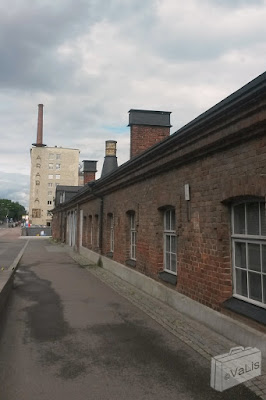If you ask Koreans for dinner recommandations, you can be sure most will say Korean barbecue is the way to go. So naturally, that's what we had. Several times.
Korean barbecue has different name depending on the type and cut of meat that you order.
 |
| Informal Samyeopsal place |
The first night in Seoul went out for Samgyeopsal (삼겹살) in a busy, informal eatery. Samgyeopsal is pork belly barbecue. We sat down at a little table/barbecue made from a drum, and ordered meat for three people. When you place you order, they fire up the barbecue, and the little side dishes are served. These side dishes are called banchan (반찬).You do not have any saying in the side dishes you'll get. That's for the kitchen to decide. But you can be sure there will be at least one dish of kimchi (김치).
 |
| Barbecue with side dishes |
Once your meat is cooked, the fun continues. Along with the banchan you got some greens. This can be different types of lettuce, and usually you also get a few wild sesame (perilla) leaves. Put a piece of meat on there, add some sauces and/or veggies, fold the leaf and enjoy your bundle of yumminess.
Generally the staff will help you with cooking, or take over if they think you are not cooking it correctly: we smoked out that first place! Whoops....
 |
| Consecutive steps of our 2nd barbecue |
So we had another go a few nights later. In a slightly fancier restaurant that had electric cooking plates installed in the table. We picked a leaner cut of pork this time. In this restaurant, the ritual started with some vegetables on the plate, carefully put in the correct position. Then the meat was put on there, and..... cut into strips with the ultimate Korean cooking utensil: scissors.
The strips were cooked, and then flambéed.
After this dinner, a dessert was cooked on that same plate, consisting of rice and cheese.
 |
| In a supermarket, pretty lettuce is slod by the leaf! |
Our third and final barbecue was in Jeju-si, with the famous Jeju black pig. This time was a combination of the previous barbecues. A fancy table plate with streaky belly meat. The people at the table next to us were no shy in telling us if we did something wrong. We had to place the giant mushroom at the correct position (left side, not right side), cook the meat longer before cutting it, and not put the veggies on there just yet. Did I mention the Koreans are quite fond of doing things in the correct manner?
 |
| Barbecue basics: banchan, leaves and scissors |
Since these barbecues tend to be smelly, you can always get a big plastic bag to put your coats in. You can order drinks with you meal, but water is served for free in any restaurant.





























.jpg)
.jpg)


.jpg)
.jpg)

.jpg)
.jpg)










